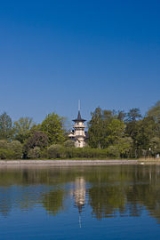
Kesäranta
Encyclopedia

Official residence
An official residence is the residence at which heads of state, heads of government, gubernatorial or other senior figures officially reside...
of the Prime Minister of Finland
Prime Minister of Finland
The Prime Minister is the Head of Government of Finland. The Prime Minister is appointed by the President, who is the Head of State. The current Prime Minister is Jyrki Katainen of the National Coalition Party.-Overview:...
. It is located in the Meilahti
Meilahti
Meilahti is a neighbourhood of Helsinki between Mannerheimintie and a bay named Seurasaarenselkä. Most of the houses in Meilahti were built in the 1930s and 1940s. Meilahti is home to over 6700 people including the President of Finland Tarja Halonen who lives on the shore in the President's...
area of Helsinki
Helsinki
Helsinki is the capital and largest city in Finland. It is in the region of Uusimaa, located in southern Finland, on the shore of the Gulf of Finland, an arm of the Baltic Sea. The population of the city of Helsinki is , making it by far the most populous municipality in Finland. Helsinki is...
, overlooking a bay on the north-west side of the city. The Finnish name Kesäranta means "summer shore". The residence is owned by the Finnish state through Senate Properties
Senate Properties
Senate Properties is a Finnish unincorporated state-owned enterprise, which manages a major part of the real estate assets owned by the Republic of Finland.-History:...
.
Designed and built in 1873 as the summer villa of architect Frans Ludvig Calonius, the building was originally named Villa Bjälbo. At the time of its construction, Meilahti lay outside the boundaries of Helsinki. Initially, Kesäranta was a two-storey wooden villa, but in 1887, after it was acquired by Carl Robert Igantius, a cashier at the Bank of Finland
Bank of Finland
The Bank of Finland is the central bank of Finland. It is the fourth oldest central bank in the world.-History:The Bank of Finland was established on 1 March in 1812 in the city of Turku by Alexander I of Russia. In 1819 it was relocated to Helsinki...
, the building was altered to the designs of Elia Heikel, who added a 20-metre tower and a bayside veranda to the building.
In 1904, the villa was purchased by the State to serve as the summer residence of the Governor-General of Finland
Governor-General of Finland
Governor-General of Finland ; was the military commander and the highest administrator of Finland sporadically under Swedish rule in the 17th and 18th centuries and continuously in the autonomous Grand Duchy of Finland between 1808 and 1917.-Swedish rule:...
. Architect Johan Jakob (Jac) Ahrenberg was commissioned to make the necessary changes to the building and its furnishings. A new kitchen wing was attached to the main building and a glazed veranda was built on to the side of the building facing the sea. The villa served as the summer residence of Governor Generals Obolenski, Gerhard, Boeckmann, and Franz Albert Seyn
Franz Albert Seyn
Franz Albert Seyn was a Russian general who was Governor-General of Finland between November 24, 1909 and March 16, 1917....
.
After Finland gained its independence in 1917, and the Finnish Civil War
Finnish Civil War
The Finnish Civil War was a part of the national, political and social turmoil caused by World War I in Europe. The Civil War concerned control and leadership of The Grand Duchy of Finland as it achieved independence from Russia after the October Revolution in Petrograd...
in 1918, the German general Rüdiger von der Goltz
Rüdiger von der Goltz
Gustav Adolf Joachim Rüdiger, Graf von der Goltz was German Army general during World War I. After World War I he was the commander of the army of the Baltic German-established Government of Latvia, which played an instrumental role in the defeat of Russian Bolsheviks and their local allies in...
lived there briefly. Carl Gustaf Emil Mannerheim
Carl Gustaf Emil Mannerheim
Baron Carl Gustaf Emil Mannerheim was the military leader of the Whites in the Finnish Civil War, Commander-in-Chief of Finland's Defence Forces during World War II, Marshal of Finland, and a Finnish statesman. He was Regent of Finland and the sixth President of Finland...
also used Kesäranta as an occasional residence during his term as Regent, or Protector of State, from 1918 to 1919. Since then, Kesäranta has served as the Prime Minister’s Official Residence.
In the summertime, the Council of State
Finnish Council of State
The Cabinet of Finland is the body that directs the Government of Finland. However, in governmental translations to English, the distinction is often blurred between cabinet and government in the wider sense...
holds its informal evening sessions at Kesäranta. These take place on Wednesday evenings and date back to the 1930s, when Prime Minister Aimo Cajander
Aimo Cajander
Aimo Kaarlo Cajander was, outside of botany, best known as Prime Minister of Finland up to the Winter War....
adopted the practice of inviting ministers to Kesäranta to discuss and prepare matters to be handled in the Government plenary session on Thursday.
A thorough renovation of the main building took place in the 1950s and again in the 1980s. The main building was restored to look as it did at the beginning of the century, including rebuilding the tower and veranda, which had been pulled down in the 1950s. The courtyard of Kesäranta includes a seaside sauna, maintenance building, guard's house, pavilion, jetty and tennis court.

